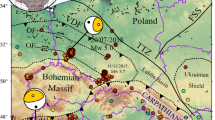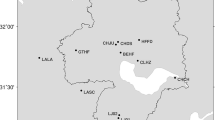Abstract
High-precision Global Positioning System (GPS) measurements from 2002 to 2017 in Nepal has been analyzed and modeled with Autoregressive Moving Average (ARMA) method. The measured velocities of the GPS sites in ITRF-2014 indicate ~ 6–12 mm/year N–S convergence inside the Nepal between India and Tibet. This convergence occurs in the southern and western border of Nepal, but it is negligible to the eastern border of Nepal. ARMA-modeled result of India-fixed velocities is able to successfully model (within ~ 0.5 mm/year) the current measured velocities in Nepal. Synthetic or modeled velocities using ARMA method and measured velocity have difference ~ 2 mm/year at some sites. This indicates the possibility of very small level of a ductile deformation. In the present best-fit ARMA model, the modeled velocities ~ 8–10 mm/year convergence taken up from northern to southern boundaries of Nepal indicates slip along active Main Himalayan Thrust (MHT) which is the cause of change in tectonic strain and may be able to trigger earthquakes inside the country. Dislocation modeling of active MHT is also carried out in the study using GPS vertical displacement. The geometric model of the MHT is characterized by a rectangular plane with dip angle of 9.5° and the reverse kinematics with a slip of 19 mm/year. The thrust is located at a depth of 20 km. In addition, the regional deformation of the Nepal has been checked by baseline measurement and coordinate stability of GPS sites for the different zones. The baseline divergence and convergence of nearest GPS sites have been tested using triangular sites. The summary of regional deformation implies N–S convergence only and rules out any type of E–W convergence. Finally, the investigation of observed and modeled strain confirms that there is no significant strain accumulation due to localized regional deformation or earthquakes specific to the active dislocations and faults. This suggests that the convergence from northern to southern boundaries of Nepal is associated with the slip along the MHT only.









Similar content being viewed by others
References
Ansari K (2014) Quantification of slip along deformation using finite element method. J Res Environ Earth Sci 1(1):25–28
Ansari K, Mukul M, Jade S (2014) Dislocation modelling of the 1997–2009 high-precision global positioning system displacements in Darjiling–Sikkim Himalaya, India. In: International Conference on Earth Science and Climate Change (ICESCC 2014), Dubai, United Arab Emirates vol 8, no 10, pp 609–612
Ansari K, Corumluoglu O, Sharma SK (2017) Numerical simulation of crustal strain in Turkey from continuous GNSS measurements in the interval 2009–2017. J Geod Sci 11:113–130. https://doi.org/10.1515/jogs-2017-0013
Avouac JP (2003) Mountain building, erosion, and the seismic cycle in the Nepal Himalaya. Adv Geophys 46:1–80
Bettinelli P, Avouac JP, Flouzat M, Jouanne F, Bollinger L, Willis P, Chitrakar GR (2006) Plate motion of India and interseismic strain in the Nepal Himalaya from GPS and DORIS measurements. J Geodesy 80(8):567–589. https://doi.org/10.1007/s00190-006-0030-3
Bilham R (1995) Location and magnitude of the 1833 Nepal earthquake and its relation to the rupture zones of contiguous great Himalayan earthquakes. Curr Sci 69(2):101–128. http://www.jstor.org/stable/24097233?seq=1#page_scan_tab_contents. Accessed 23 Oct 2017
Bilham R, Gaur VK, Molnar P (2001) Himalayan seismic hazard. Science 293:1442–1444. https://doi.org/10.1126/science.1062584
Boyer SE, Elliott D (1982) Thrust systems. Am Assoc Pet Geol 66:1196–1230
Chen Q, Freymueller JT, Yang Z, Xu C, Jiang W, Wang Q, Liu J (2004) Spatially variable extension in southern Tibet based on GPS measurements. J Geophys Res 109:B09401. https://doi.org/10.1029/2002JB002350
Christensen NI (1996) Poisson ratio and crustal seismology. J Geophys Res 101(B2):3139–3156. https://doi.org/10.1029/95JB03446
Crouch SL, Starfield AM, Rizzo FJ (1983) Boundary element methods in solid mechanics. J Appl Mech 50:704. http://adsabs.harvard.edu/abs/1983JAM.....50..704C. Accessed 23 Oct 2017
Dahal RK (2006) Geology of Nepal, published in personal home page. http://www.ranjan.net.np
Demets C, Gordon RG, Argus DF (2010) Geologically current plate motions. Geophys J Int 181(1):1–80. https://doi.org/10.1111/j.1365-246X.2009.04491.x
Dmitrieva K, Segall P, DeMets C (2015) Network-based estimation of time-dependent noise in GPS position time series. J Geodesy 89(6):591–606. https://doi.org/10.1007/s00190-015-0801-9
Dube SK (2017) Earthquake in Nepal: a miserable environmental hazard visited by nature. Acad Voices Multidiscip J 5:56–66. https://www.nepjol.info/index.php/AV/article/view/15853. Accessed 23 Oct 2017
Fu Y, Freymueller JT (2012) Seasonal and long-term vertical deformation in the Nepal Himalaya constrained by GPS and GRACE measurements. J Geophys Res Solid Earth. https://doi.org/10.1029/2011JB008925
Jackson M, Bilham R (1994) Constraints on Himalayan deformation inferred from vertical velocity fields in Nepal and Tibet. J Geophys Res Solid Earth 99(B7):13897–13912. https://doi.org/10.1029/94JB00714
Jade S, Mukul M, Gaur VK, Kumar K, Shrungeshwar TS, Satyal GS, Dumka RK, Jagannathan S, Ananda MB, Kumar PD, Banerjee S (2014) Contemporary deformation in the Kashmir–Himachal, Garhwal and Kumaon Himalaya: significant insights from 1995 to 2008 GPS time series. J Geod 88:539–557. https://doi.org/10.1007/s00190-014-0702-3
Jade S, Shrungeshwara TS, Kumar K, Choudhury P, Dumka RK, Bhu H (2017) India plate angular velocity and contemporary deformation rates from continuous GPS measurements from 1996 to 2015. Sci Rep 7(1):11439. https://doi.org/10.1038/s41598-017-11697-w
Jouanne F, Mugnier JL, Gamond JF, Le Fort P, Pandey MR, Bollinger L, Flozat M, Avouac JP (2004) Current shortening across the Himalaya of Nepal. Geophys J Int 57:1–14. https://doi.org/10.1111/j.1365-246X.2004.02180.x
King RW, Bock Y (2010) Documentation of the GAMIT GPS analysis software. Massachusetts Institute of Technology, Cambridge
Kobayashi T, Morishita Y, Yarai H (2015) Detailed crustal deformation and fault rupture of the 2015 Gorkha earthquake, Nepal, revealed from ScanSAR-based interferograms of ALOS-2. Earth Planets Space 67(1):201. https://link.springer.com/article/10.1186/s40623-015-0359-z. Accessed 23 Oct 2017
Lave J, Avouac JP (2000) Fluvial incision and tectonic uplift across the Himalayas of central Nepal. J Geophys Res 106(B11):26561–26591. https://doi.org/10.1029/2001JB000359
Li J, Miyashita K, Kato T, Miyazaki S (2000) GPS time series modeling by autoregressive moving average method: application to the crustal deformation in central Japan. Earth planets space 52(3):155–162, https://link.springer.com/article/10.1186/BF03351624
Lin J, Stein RS (2004) Stress triggering in thrust and subduction earthquakes, and stress interaction between the southern San Andreas and nearby thrust and strike-slip faults. J Geophys Res 109:B02303. https://doi.org/10.1029/2003JB002607
Mitra G, Bhattacharyya K, Mukul M (2010) The Lesser Himalayan Duplex in Sikkim: Implications for variations in Himalayan shortening. J Geol Soc India, 75, 276–288. https://link.springer.com/article/10.1007%2Fs12594-010-0016-x?LI=true. Accessed 23 Oct 2017
Montillet JP, Williams SDP, Koulali A, McClusky SC (2015) Estimation of offsets in GPS time-series and application to the detection of earthquake deformation in the far-field. Geophys J Int 200(2):1207–1221. https://doi.org/10.1093/gji/ggu473
Mukherjee S (2013) Higher Himalaya in the Bhagirathi section (NW Himalaya, India): its structures, backthrusts and extrusion mechanism by both channel flow and critical taper mechanisms. Int J Earth Sci 102:1851–1870. https://doi.org/10.1007/s00531-012-0861-5
Mukherjee S, Koyi HA (2010) Higher Himalayan Shear Zone, Sutlej section- structural geology and extrusion mechanism by various combinations of simple shear and channel flow. Int J Earth Sci 99:1083–1110. https://doi.org/10.1007/s00531-009-0459-8
Mukherjee S, Koyi HA, Talbot CJ (2012) Implications of channel flow analogue models in extrusion of the Higher Himalayan Shear Zone with special reference to the out-of-sequence thrusting. Int J Earth Sci 101:253–272. https://doi.org/10.1007/s00531-011-0650-6
Mukherjee S, Punekar J, Mahadani T, Mukherjee R (2015) A review on intrafolial folds and their morphologies from the detachments of the western Indian Higher Himalaya.In: Mukherjee S, Mulchrone KF (eds) Ductile shear zones: from micro- to macro-scales. Wiley, Hoboken, pp 182–205
Mukul M (2000) The geometry and kinematics of the main boundary thrust and related neotectonics in the Darjiling Himalayan foldand–thrust belt. West Bengal J Struct Geol 22(9):1261–1283. https://doi.org/10.1016/S0191-8141(00)00032-8
Mukul M, Jade S, Ansari K, Matin A (2014) Seismotectonic implications of strike-slip earthquakes in the Darjiling–Sikkim Himalaya. Curr Sci 106(2):126–131
Mukul M, Jade S, Ansari K, Matin A, Joshi V (2018) Structural insights in the Himalaya from geodetic global positioning system measurements. J Struct Geol. https://doi.org/10.1016/j.jsg.2018.03.007
Okada Y (1992) Internal deformation due to shear and tensile faults in a half-space. Bull Seismol Soc Am 82(2):1018–1040. https://www.geophysik.uni-muenchen.de/~malservisi/TECTOGPS/papers/Okada92.pdf. Accessed 23 Oct 2017
Pandey MR, Tandukar RP, Avouac JP, Vergne J, Heritier T (1999) Seismotectonics of the Nepal Himalaya from a local seismic network. J Asian Earth Sci 17(5):703–712. https://doi.org/10.1016/S1367-9120(99)00034-6
Rajendran K, Parameswaran RM, Rajendran CP (2017) Seismotectonic perspectives on the Himalayan arc and contiguous areas: inferences from past and recent earthquakes. Earth Sci Rev 173:1–30
Stevens VL, Avouac JP (2016) Millenary Mw> 9.0 earthquakes required by geodetic strain in the Himalaya. Geophys Res Lett 43(3):1118–1123
Teza G, Galgaro A (2008) Grid_strain and grid_strain3: sofware packages for strain feld computation in 2D and 3D environment. Comput Geosci 34(9):1142–1153
Toda S, Stein RS, Richards-Dinger K, Bozkurt S (2005) Forecasting the evolution of seismicity in southern California: animations built on earthquake stress transfer, J Geophys Res 110:B05S16. https://doi.org/10.1029/2004JB003415
Vernant P, Bilham R, Szeliga W, Drupka D, Kalita S, Bhattacharyya AK, Gaur VK, Pelgay P, Cattin R, Berthet T (2014) Clockwise rotation of the Brahmaputra Valley relative to India: tectonic convergence in the eastern Himalaya, Naga Hills, and Shillong Plateau. J Geophys Res Solid Earth 119:6558–6571. https://doi.org/10.1002/2014JB011196
Watson KM, Bock Y, Sandwell DT (2002), Satellite Interferometric observations of displacements associated with seasonal groundwater in the Los Angeles basin. J Geophys Res, 107(B4):2074. https://doi.org/10.1029/2001JB000470
Acknowledgements
Author appreciates the Caltech Tectonics Observatory and UNAVCO for establishing and maintaining the GPS stations in Nepal and Bhutan, and for enabling its free access. The author also thanks to Prof. Bob King from MIT for providing the GAMIT–GLOBK software and helping to resolve the issues related to the software. My sincere thank to Prof. G. Teza for giving the strain analysis software.
Author information
Authors and Affiliations
Corresponding author
Electronic supplementary material
Below is the link to the electronic supplementary material.
Rights and permissions
About this article
Cite this article
Ansari, K. Crustal deformation and strain analysis in Nepal from GPS time-series measurement and modeling by ARMA method. Int J Earth Sci (Geol Rundsch) 107, 2895–2905 (2018). https://doi.org/10.1007/s00531-018-1633-7
Received:
Accepted:
Published:
Issue Date:
DOI: https://doi.org/10.1007/s00531-018-1633-7




